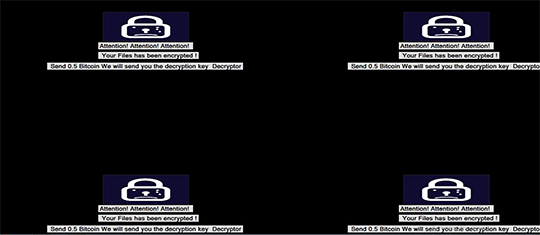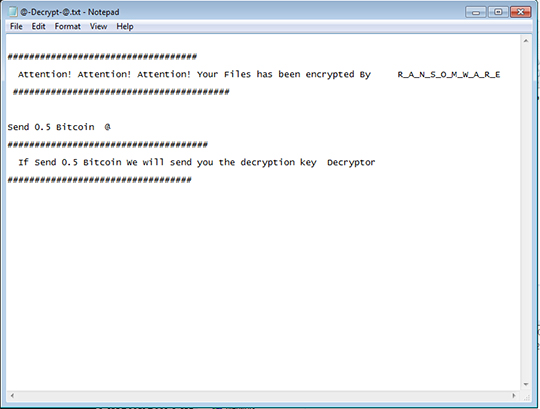RANSOM_HIDDENTEARICE.A
Ransom.HiddenTear!g1 (NORTON); Virus:Win32/Neshta.A [non_writable_container] (Microsoft);
Windows


Threat Type: Ransomware
Destructiveness: No
Encrypted: No
In the wild: Yes
OVERVIEW
Dropped by other malware, Downloaded from the Internet
This Ransomware arrives on a system as a file dropped by other malware or as a file downloaded unknowingly by users when visiting malicious sites.
It encrypts files found in specific folders. It drops files as ransom note.
TECHNICAL DETAILS
262,656 bytes
EXE
No
06 Sep 2017
Displays graphics/image, Displays message/message boxes, Encrypts files
Arrival Details
This Ransomware arrives on a system as a file dropped by other malware or as a file downloaded unknowingly by users when visiting malicious sites.
Installation
This Ransomware drops and executes the following files:
- %AppdataLocal%\Temppicc.exe
- %AppdataLocal%\Tempspesh.exe
Other Details
This Ransomware encrypts files with the following extensions:
- .txt
- .doc
- .docx
- .mp3
- .xls
- .xlsx
- .ppt
- .sql
- .wmv
- .mp4
- .mp3
- .iso
- .dll
- .jar
- .pptx
- .odt
- .jpg
- .tar
- .gz
- .bmp
- .pbm
- .rtf
- .png
- .csv
- .sql
- .mdb
- .sln
- .php
- .avi
- .mov
- .flv
- .amv
- .mpv
- .mtv
- .asp
- .aspx
- .html
- .xml
- .psd
- .exe
- .rv
- .rvx
- .ved
- .wm
- .wmv
- .TXT
- .JPG
- .rar
- .xwmv
- .wma
- .midi
- .fla
- .wma
- .ico
- .gif
- .GIF
- .ogg
- .mpg
- .icns
- .RAR
- .png
- .zip
- .BAT
- .Exe
- .c
- .exe
- .PNG
- .iso
- .7z
- .7Z
- {no extension}
Ransomware Routine
This Ransomware encrypts files found in the following folders:
- %User Profile%\Documents
- %User Profile%\Documents\Pictures
- %Desktop%
- %User Profile%\Music
- %Desktop%
- %User Startup%
- %Start Menu%\Programs
- %Application Data%
- %Favorites%
- %Program Files%
(Note: %User Profile% is the current user's profile folder, which is usually C:\Documents and Settings\{user name} on Windows 2000, XP, and Server 2003, or C:\Users\{user name} on Windows Vista and 7.. %Desktop% is the desktop folder, where it usually is C:\Documents and Settings\{user name}\Desktop in Windows 2000, Windows Server 2003, and Windows XP (32- and 64-bit); C:\Users\{user name}\Desktop in Windows Vista (32- and 64-bit), Windows 7 (32- and 64-bit), Windows 8 (32- and 64-bit), Windows 8.1 (32- and 64-bit), Windows Server 2008, and Windows Server 2012.. %User Startup% is the current user's Startup folder, which is usually C:\Documents and Settings\{user}\Start Menu\Programs\Startup on Windows 2000 and XP, and C:\Documents and Settings\{User name}\Start Menu\Programs\Startup on Windows Vista, 7, and 8.. %Start Menu% is the Start Menu folder, where it usually is C:\Documents and Settings\{user name}\Start Menu on Windows 2000, Windows Server 2003, and Windows XP (32- and 64-bit); C:\Users\{user name}\AppData\Roaming\Microsoft\Windows\Start Menu on Windows Vista (32- and 64-bit), Windows 7 (32- and 64-bit), Windows 8 (32- and 64-bit), Windows 8.1 (32- and 64-bit), Windows Server 2008, and Windows Server 2012.. %Application Data% is the Application Data folder, where it usually is C:\Documents and Settings\{user name}\Application Data on Windows 2000, Windows Server 2003, and Windows XP (32- and 64-bit); C:\Users\{user name}\AppData\Roaming on Windows Vista (32- and 64-bit), Windows 7 (32- and 64-bit), Windows 8 (32- and 64-bit), Windows 8.1 (32- and 64-bit), Windows Server 2008, and Windows Server 2012.. %Favorites% is the Favorites folder, where it usually is C:\Documents and Settings\{user name}\Favorites on Windows 2000, Windows Server 2003, and Windows XP (32- and 64-bit); C:\Users\{user name}\Favorites on Windows Vista (32- and 64-bit), Windows 7 (32- and 64-bit), Windows 8 (32- and 64-bit), Windows 8.1 (32- and 64-bit), Windows Server 2008, and Windows Server 2012.. %Program Files% is the Program Files folder, where it usually is C:\Program Files on all Windows operating system versions; C:\Program Files (x86) for 32-bit applications running on Windows 64-bit operating systems.)
It appends the following extension to the file name of the encrypted files:
- .Isis
It drops the following file(s) as ransom note:
- %Desktop%\@-Decrypt-@.txt
(Note: %Desktop% is the desktop folder, where it usually is C:\Documents and Settings\{user name}\Desktop in Windows 2000, Windows Server 2003, and Windows XP (32- and 64-bit); C:\Users\{user name}\Desktop in Windows Vista (32- and 64-bit), Windows 7 (32- and 64-bit), Windows 8 (32- and 64-bit), Windows 8.1 (32- and 64-bit), Windows Server 2008, and Windows Server 2012.)
NOTES:
This ransomware sets desktop wallpaper to:

The ransom note %Desktop%\@-Decrypt-@.txt contains:

SOLUTION
9.850
13.644.04
06 Sep 2017
13.645.00
07 Sep 2017
Step 1
Before doing any scans, Windows XP, Windows Vista, and Windows 7 users must disable System Restore to allow full scanning of their computers.
Step 2
Note that not all files, folders, and registry keys and entries are installed on your computer during this malware's/spyware's/grayware's execution. This may be due to incomplete installation or other operating system conditions. If you do not find the same files/folders/registry information, please proceed to the next step.
Step 3
Search and delete these files
- %Desktop%\@-Decrypt-@.txt
- %AppdataLocal%\Temppicc.exe
- %AppdataLocal%\Tempspesh.exe
Step 4
Scan your computer with your Trend Micro product to delete files detected as RANSOM_HIDDENTEARICE.A. If the detected files have already been cleaned, deleted, or quarantined by your Trend Micro product, no further step is required. You may opt to simply delete the quarantined files. Please check this Knowledge Base page for more information.
Step 5
Reset your Desktop properties
Step 6
Restore encrypted files from backup.
Did this description help? Tell us how we did.

